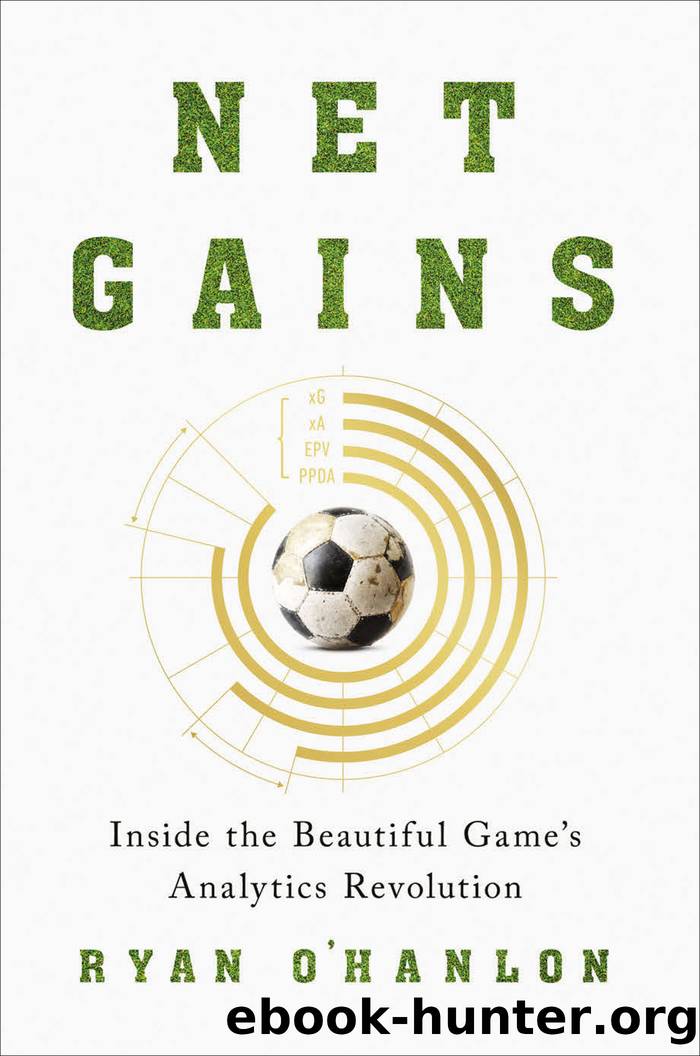Net Gains by O'Hanlon Ryan;

Author:O'Hanlon, Ryan;
Language: eng
Format: epub
Publisher: Abrams, Inc.
Published: 2022-10-18T00:00:00+00:00
CHAPTER SEVEN
BIG TED
About 4,000 people live in De Motte, Indiana, and about 3,840 of them are white. Itâs one of those midwestern towns that exists for no reason other than âitâs been a while since the last stop, letâs put a railroad station here.â The town was named after Mark De Motte, a colonel in the Union army and a one-term US congressman. Every year, the town celebrates something called âTouch of Dutch,â your standard small-town parade-plus-festival, just with some miniature windmills and wooden shoes added in. Ted Knutson remembers people talking about how his hometown once held the Guinness World Record for the most churches per capita, but I have been unable to confirm that fact. âWeâre out in the cornfields, and you donât have a lot of choice,â he said. As for soccer? âWe didnât have it.â
In Paris, they have plenty of it. Were someone able to figure out a way to codify the idea, the Ãle-de-France, as Greater Paris is known, would probably hold the Guinness World Record for world-class soccer players per capita. At the 2018 World Cup in Russia, 15 of the players on the French squad were from Paris, while other cities produced no more than 10 for their respective countries. Per an analysis by the sociologist Darko DukiÄ, the estimated transfer value of those Parisian players was â¬483 million; players from Buenos Aires were next at â¬180 million. Across the five World Cups from 2002 through 2018, 60 of the players were Parisiansâ10 more than were from Buenos Aires.
Except, this is a relatively new phenomenonâboth within France and within the history of European soccer. While there are all kinds of socialistic methods to maintain competition and redistribute wealth and talent across the major American sports, the best teams still tend to be the ones in the biggest and richest cities. Across the NBA, MLB, NFL, NHL, and MLS, the city with the most championships is New York, followed by Boston, Los Angeles, and Chicago. Boston is the outlier, perhaps, but New York, Los Angeles, and Chicago are the three biggest cities in the country. Drafts, salary caps, equal distributions of TV revenue? They havenât prevented the talent from trickling toward the biggest markets.
Given that European soccer has no draft, distributes TV revenue unequally, and limits spending only as a percentage of overall revenue, you might expect the list of champions to read like a list of the richest cities on the continent: Paris, London, Moscow. Yet, those three cities have combined for only two Champions League titlesâand the first one didnât come until 2008. Throw in the likes of Rome, Istanbul, and Berlin, and the number stays stuck at two. Meanwhile, the city of Liverpool has five, Manchester has three, Porto and Nottingham each have two, while Birmingham, Rotterdam, and Dortmund each have one. Not quite De Motte, Iowa, but not quite the fashion or economic capitals of Europe, either. Remember how the best early English clubs sprang up around factories? This happened all throughout Europe, in smaller industrial towns.
Download
This site does not store any files on its server. We only index and link to content provided by other sites. Please contact the content providers to delete copyright contents if any and email us, we'll remove relevant links or contents immediately.
Zero to IPO: Over $1 Trillion of Actionable Advice from the World's Most Successful Entrepreneurs by Frederic Kerrest(4055)
Machine Learning at Scale with H2O by Gregory Keys | David Whiting(3633)
Harry Potter and the Goblet Of Fire by J.K. Rowling(3610)
Never by Ken Follett(3528)
Ogilvy on Advertising by David Ogilvy(3334)
Shadow of Night by Deborah Harkness(3176)
The Man Who Died Twice by Richard Osman(2808)
Book of Life by Deborah Harkness(2720)
My Brilliant Friend by Elena Ferrante(2703)
How Proust Can Change Your Life by Alain De Botton(2613)
0041152001443424520 .pdf by Unknown(2597)
Will by Will Smith(2580)
The Tipping Point by Malcolm Gladwell(2561)
How to Pay Zero Taxes, 2018 by Jeff A. Schnepper(2500)
Purple Hibiscus by Chimamanda Ngozi Adichie(2486)
Hooked: A Dark, Contemporary Romance (Never After Series) by Emily McIntire(2422)
Rationality by Steven Pinker(2149)
Borders by unknow(2119)
Daughter of Smoke and Bone by Laini Taylor(2081)
